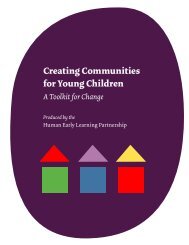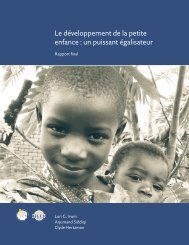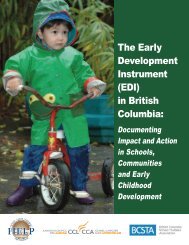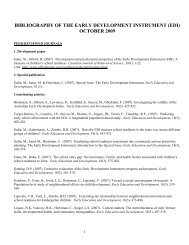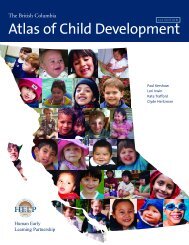Total Environment Assessment Model for Early Child Development
Total Environment Assessment Model for Early Child Development
Total Environment Assessment Model for Early Child Development
Create successful ePaper yourself
Turn your PDF publications into a flip-book with our unique Google optimized e-Paper software.
<strong>Total</strong> <strong>Environment</strong> <strong>Assessment</strong> <strong>Model</strong><br />
<strong>for</strong> <strong>Early</strong> <strong>Child</strong> <strong>Development</strong><br />
Chapter 3:<br />
The Residential Community<br />
as a Sphere of Influence<br />
Overview<br />
<strong>Child</strong>ren and their families live in localities<br />
or residential communities, though the<br />
type of locality/community varies tremendously.<br />
In rural settings, people generally<br />
reside in village-based communities, while<br />
in urban settings, the <strong>for</strong>ms of clustering may<br />
be more diverse, and includes neighbourhood<br />
or slum communities. Nonetheless, however,<br />
there are core features of all localities that<br />
have been identified as being extremely<br />
important <strong>for</strong> ecd.<br />
The focus of this section is to identify<br />
and discuss the key aspects of the residential<br />
community, and where available, highlight<br />
the associated evidence. Un<strong>for</strong>tunately,<br />
most of the evidence in this regard has been<br />
conducted in urban neighborhood contexts<br />
in the resource-rich nations, particularly the<br />
United States and the United Kingdom. The<br />
research conducted in these nations does,<br />
however, provide insights <strong>for</strong> resource-poor<br />
nations, and suggests avenues <strong>for</strong> further<br />
research in other contexts.<br />
The pertinent features of a residential<br />
community <strong>for</strong> children include the economic<br />
environment, the physical environment, the<br />
service environment, and the social environment<br />
[103]. Inequalities in these residential<br />
characteristics result in inequalities in health.<br />
The economic environment of a locality<br />
is critical <strong>for</strong> the well-being of children,<br />
and is heavily linked with the other types<br />
of environments. Economic well-being of a<br />
locality can be characterized in several ways,<br />
including the aggregate financial stability of<br />
the families which reside in the locality (i.e.<br />
the neighbours), and the financial resources of<br />
the community in total (i.e. through government<br />
sources such as property taxes), though<br />
the most studied aspect is the <strong>for</strong>mer.<br />
The socioeconomic well-being of a<br />
residential community is most often defined<br />
as the average or median family income level,<br />
the percentage of residents with a high school<br />
diploma, or the percentage of employed or<br />
unemployed individuals in the community<br />
[20]. Studies have found that high levels<br />
of ses in a neighbourhood are associated<br />
with better school readiness and school<br />
achievement in younger children (including<br />
intelligence quotients, verbal ability, and<br />
reading recognition). In older children and<br />
adolescents, higher levels of ses are associated<br />
with fewer externalizing behaviors, less<br />
peer reported aggression, less delinquent and<br />
criminal behavior, and less peer rejection [20].<br />
Socioeconomic aspects of neighborhoods<br />
are thought to affect well-being through their<br />
influence on the physical, service, and social<br />
environments. There is a clear inverse association<br />
between the ses of a community and the<br />
extent to which its residents will be exposed<br />
to toxic or otherwise hazardous exposures<br />
such as wastes, air pollutants, poor water<br />
quality, excessive noise, residential crowding,<br />
poor housing quality, and the like [104].<br />
The financial resources of neighbours also<br />
bear directly on the extent of services that are<br />
available in a residential community. These<br />
include institutions and facilities <strong>for</strong> learning<br />
and recreation, child care, medical facilities,<br />
access to transportation, food markets, and<br />
opportunities <strong>for</strong> employment [20].<br />
Finally, the social environment of a<br />
neighbourhood is also associated with its<br />
degree of socioeconomic stability. The underpinning<br />
<strong>for</strong> exploring the social environment<br />
of neighborhoods comes largely from the<br />
concept of ‘social capital’, which has been<br />
explicated extensively by a host of sociologists<br />
[105, 106, 107]. The essential premise of this<br />
concept is that there are social properties of<br />
entire communities or societies that deserve<br />
distinct characterization, over and above the<br />
phenomenon of describing an individual’s (or<br />
family’s) social relationships [105].<br />
This includes the extent to which adults<br />
and children in communities are linked to<br />
one another, whether there is reciprocated<br />
exchange (of in<strong>for</strong>mation, in-kind services,<br />
and other <strong>for</strong>ms of support), and whether<br />
there is in<strong>for</strong>mal social control and mutual<br />
support. This latter social feature of communities<br />
is tied to the notion of ‘collective<br />
efficacy’, which refers to a “shared belief of a<br />
collectivity [108].” Collective efficacy empha-<br />
Spheres of<br />
Influence:<br />
Residential<br />
Community<br />
41



